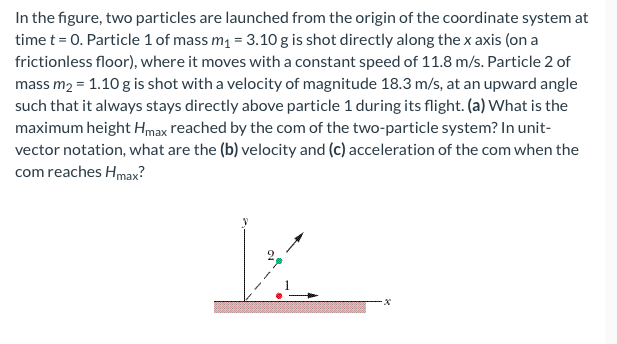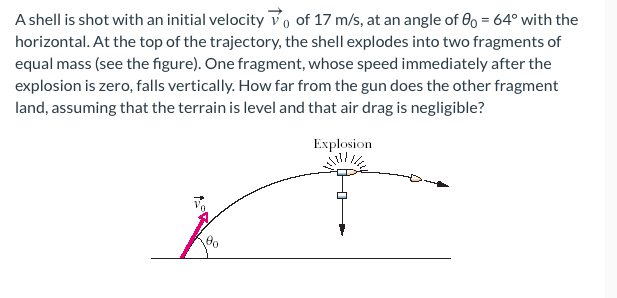In the figure, two particles are launched from the origin of the coordinate system at time t = 0. Particle 1 of mass m₁ = 3.10 g is shot directly along the x axis (on a frictionless floor), where it moves with a constant speed of 11.8 m/s. Particle 2 of mass m₂ = 1.10 g is shot with a velocity of magnitude 18.3 m/s, at an upward angle such that it always stays directly above particle 1 during its flight. (a) What is the maximum height Hmax reached by the com of the two-particle system? In unit- vector notation, what are the (b) velocity and (c) acceleration of the com when the com reaches Hmax? x
In the figure, two particles are launched from the origin of the coordinate system at time t = 0. Particle 1 of mass m₁ = 3.10 g is shot directly along the x axis (on a frictionless floor), where it moves with a constant speed of 11.8 m/s. Particle 2 of mass m₂ = 1.10 g is shot with a velocity of magnitude 18.3 m/s, at an upward angle such that it always stays directly above particle 1 during its flight. (a) What is the maximum height Hmax reached by the com of the two-particle system? In unit- vector notation, what are the (b) velocity and (c) acceleration of the com when the com reaches Hmax? x
Classical Dynamics of Particles and Systems
5th Edition
ISBN:9780534408961
Author:Stephen T. Thornton, Jerry B. Marion
Publisher:Stephen T. Thornton, Jerry B. Marion
Chapter9: Dynamics Of A System Of Particles
Section: Chapter Questions
Problem 9.42P
Related questions
Topic Video
Question

Transcribed Image Text:In the figure, two particles are launched from the origin of the coordinate system at
time t = 0. Particle 1 of mass m₁ = 3.10 g is shot directly along the x axis (on a
frictionless floor), where it moves with a constant speed of 11.8 m/s. Particle 2 of
mass m₂ = 1.10 g is shot with a velocity of magnitude 18.3 m/s, at an upward angle
such that it always stays directly above particle 1 during its flight. (a) What is the
maximum height Hmax reached by the com of the two-particle system? In unit-
vector notation, what are the (b) velocity and (c) acceleration of the com when the
com reaches Hmax?

Transcribed Image Text:A shell is shot with an initial velocity of 17 m/s, at an angle of 0o = 64° with the
horizontal. At the top of the trajectory, the shell explodes into two fragments of
equal mass (see the figure). One fragment, whose speed immediately after the
explosion is zero, falls vertically. How far from the gun does the other fragment
land, assuming that the terrain is level and that air drag is negligible?
Explosion
Expert Solution
This question has been solved!
Explore an expertly crafted, step-by-step solution for a thorough understanding of key concepts.
This is a popular solution!
Trending now
This is a popular solution!
Step by step
Solved in 3 steps

Knowledge Booster
Learn more about
Need a deep-dive on the concept behind this application? Look no further. Learn more about this topic, physics and related others by exploring similar questions and additional content below.Recommended textbooks for you

Classical Dynamics of Particles and Systems
Physics
ISBN:
9780534408961
Author:
Stephen T. Thornton, Jerry B. Marion
Publisher:
Cengage Learning

Principles of Physics: A Calculus-Based Text
Physics
ISBN:
9781133104261
Author:
Raymond A. Serway, John W. Jewett
Publisher:
Cengage Learning

University Physics Volume 1
Physics
ISBN:
9781938168277
Author:
William Moebs, Samuel J. Ling, Jeff Sanny
Publisher:
OpenStax - Rice University

Classical Dynamics of Particles and Systems
Physics
ISBN:
9780534408961
Author:
Stephen T. Thornton, Jerry B. Marion
Publisher:
Cengage Learning

Principles of Physics: A Calculus-Based Text
Physics
ISBN:
9781133104261
Author:
Raymond A. Serway, John W. Jewett
Publisher:
Cengage Learning

University Physics Volume 1
Physics
ISBN:
9781938168277
Author:
William Moebs, Samuel J. Ling, Jeff Sanny
Publisher:
OpenStax - Rice University

College Physics
Physics
ISBN:
9781305952300
Author:
Raymond A. Serway, Chris Vuille
Publisher:
Cengage Learning